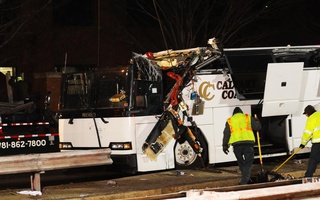“This is an extraordinary situation,” reads the Norwegian Air website, with the Scandinavian penchant for stony understatement. Vulcan, Roman god of fire and the being after whom volcanoes owe their name, is emptying his lungs this week, blowing out a slow stream of smoke and ash that drifts eastward still. While commentators grapple with the name of Icelandic volcano Eyjafjallajökull—its ancient, unpronounceable appellation—European airlines as far east as Moscow are choking under the strain, losing hundreds of millions of dollars in refunds and transfers as whole departures columns read “Cancelled.” England, perhaps hardest hit, even announced it would send Royal Navy warships to rescue stranded Britons.
“It is impossible to attain the depths of reality by describing its surface manifestations,” a German writer once wrote. Something about this goes beyond the mere fact of the ash or any inconvenience. The volcano opened a window onto a reality that resists explanation, becoming a hot primeval eruption to counter the cold steel of airports, the efficiency of modern infrastructure. Ancients thought the clouds of dust emerging from the Sicilian crater Vulcan’s lip were the industry of the god’s forge as he beat out thunderbolts for Jupiter. Some of the incredulity behind that legend-making became comprehensible as in the midst of trying to arrange alternate routes home, punching variation upon variation of possible routes into the computer, one could see passengers and officials look up in amazement, turn to one another, say: “An Icelandic volcano…”
From the ground in western Europe, the sky looked dazzlingly blue; it was hard to believe anything had happened at all. Like the Airborne Toxic Event in Don DeLillo’s “White Noise,” its invisibility added to its incomprehensibility. But unlike in the novel, the volcanic ash is not something man-made; that it comes from nature, and yet seems so foreign, makes it all the stranger. Sartre wrote that “Dissemblers arrange to keep secret dimensions to themselves, like the Russian whose friends told me: he has twelve storeys of sincerity, you have only reached the fourth. This type is always silent.” Nature is the greatest dissembler of all: Remaining silent, her mystification is broad.
For me, the ash meant 23 hours of trains from Copenhagen to Prague, including four transfers in small German towns. Others, including students trying to get back from spring break, faced far more arduous journeys by bus or ferry. At railway stations, taxi drivers waving cardboard signs advertising rides for thousands of euros weren’t doing bad business. DeutscheBahn overbooked in trying to get people home, and for a few hours of the journey we passengers without seat reservations sat on the ground between wagons with legs drawn up beneath us, near the lavatory and the kitchen trash, making light of the cramped space. Outside, the Hamburg region rolled by in a magic lantern of luminous green grass, black pines, and farm houses. A French couple placated their crying baby in stroller with multiple petits gateaux; a Czech woman, tabloid in lap, stared for a while at the no-smoking sign and then lit up. Everyone found their way of coping.
This volcano, so mystical, has a history of confusion. When it erupted in 1821, it did so for months, resulting in flooding from glacier runs and heavy ashfall; a full year later, puzzled farmers looked on in wonder as hundreds of cattle died from what would later be known as delayed fluoride poisoning from the ash. The range of emotions to which the volcano has given rise, from frustration, to doubt, to fear, affect everyone. Much culture is nationalistic and specific—even as globalization expands brands like Coca-Cola and the Black Eyed Peas, artists turn inward to create specific products like wicker baskets or plum wine or marionettes. But the natural event transcends. As the art critic John Berger put it: “The notion that art is the mirror of nature is one that only appeals in periods of skepticism. Art does not imitate nature, it imitates a creation, sometimes to propose an alternative world, sometimes simply to amplify, to confirm, to make social the brief hope offered by nature. Art is an organized response to what nature allows us to glimpse occasionally. Art sets out to transform the potential recognition into an unceasing one. It proclaims man in the hope of receiving a surer reply… the transcendental face of art is always a form of prayer.”
And so, this volcanic eruption is far more than just an inconvenience to passengers at Heathrow, or a less impressive Krakatoa, as Simon Winchester suggested in the International Herald Tribune this weekend. As of this writing my flight to London has just been cancelled; it will be a long trip home. Peering into the dark heart of the crater the only appropriate emotion seems to be awe and a profound humility as the volcano continues to release its ash, fascinating scientists, eluding comprehension, defying human control.
Jessica A. Sequeira ’11, a former Crimson associate editorial editor, is a social studies concentrator in Winthrop House currently studying abroad at the University of Cambridge. Her column appears on alternate Thursdays.
Read more in Opinion
A Listless WorldRecommended Articles
-
Falling Flight StandardsThe airline industry is desperate. It is pushing its customers’ patience and will likely continue to do so with outrageous fees and ridiculous ideas.
-
Students Stuck in ‘Shuttle’ Mix-UpAbout thirty students boarded an unmarked, white van that they mistakenly thought to be a Harvard shuttle to the Quad Saturday night. Instead, they found themselves facing a driver demanding $5 per person before allowing them to disembark.
-
 More Than 30 Injured in Bus Crash Following Trip to Harvard
More Than 30 Injured in Bus Crash Following Trip to Harvard -
 "Non-Stop" Falters
"Non-Stop" Falters













